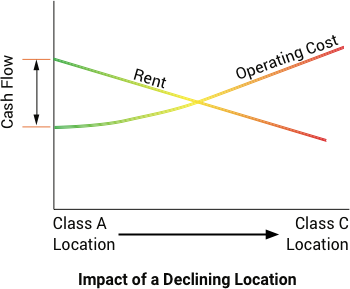

6 Key Factors to Consider When Selecting An Investment Location
Selecting A Good Investment Location
If you don't know where you are going, you might wind up someplace else. Yogi Berra
Yogi Berra's words are as true today as they were when he said them. So we share a common destination, below are three criteria we believe every investment property must meet.
- Sustained profitability - The property must generate a positive cash flow today and into the foreseeable future.
- Likely to appreciate over time - You would never buy a property just for appreciation but appreciation is very desirable.
- Located in an area where you can make money and business risks are low. Key factors include state income tax, property tax, insurance cost and landlord favorable regulations. Regulations include property related laws that impact landlords like the time and cost of evictions, rent control, code compliance requirements, etc.
Fortunately, real estate is the most forgiving of all the investment options. As long as you buy property in a good location, all but the worst mistakes will be corrected over time through appreciation, inflation and rent increases. The corollary is that if you choose a bad location, you've lost before you start.
Below are some of the key location selection criteria.
Job Quantity and Quality Growth
Job quantity and job quality must be considered together. Why? Suppose your tenants were working at a manufacturing job and earning $40/Hr. Suppose that the factory went away and now the tenant is working a services industry job earning $10/Hr. Your tenant pool is still employed, but they could no longer afford the rent they did before. This occurred in many parts of the US and rents and property prices fell, and are continuing to fall. But it isn't enough just to have jobs. If a location is not attracting new employers, the location is already declining. Companies are like people. Companies start up, grow, mature, and die. Only if new employers are moving into the location will it stay economically viable into the foreseeable future.

Population Growth
Population growth is critical. Only buy properties in a location where the population is growing at a sustainable rate. (Do not buy in boom towns, they tend to go down as fast as they go up.) Why is population growth so important? If the population is declining, people are moving out of the area. With declining population, demand falls and housing prices and rental rates fall as well. If people are moving into an area, housing prices and rental rates are likely to rise due to increasing demand.
Urban Sprawl
In every major city I've seen there are areas which were once highly desirable and over time have become distressed areas. One major cause of such changes is urban sprawl. People want newer floor plans, newer homes, less crime, better schools, etc. And, if they have the income, they will move to such areas. As people with money move out of an area, those left behind will, on average, have lower incomes. Property prices will then start to fall because the remaining residents have less income, so demand will be for lower-priced properties. As property prices fall, property tax revenues will fall. City services are dependent on property tax and sales tax revenues. So, as revenues fall, cities have no choice but to cut services. This starts a downward trend from which few locations have reversed.
Property Price Trend
Too often new investors choose a location because it is cheap. Property prices are a reflection of demand. Low demand, low prices. If you look at the $/SqFt, corrected for inflation, and prices are going down, look somewhere else. See Investing in Declining Markets for more information. The graphic below illustrates what is likely to happen with rents and property prices. Remember that return calculations are only a snapshot in time. Return calculations tell you nothing about the future so things could look great today even though the location is in decline.

Crime
Stable or increasing property values and rents rarely occur in areas with high or increasing crime rates. When crime increases, people with sufficient income will move to areas with lower crime. Also, new businesses will not move to high crime areas. Why should they? The company will likely be relocating a management team and who would choose to relocate to a high crime area. If the location you are considering is on the list of the top 100 most dangerous cities in the US, look somewhere else. See Top 100 most dangerous cities. Even if you believe the level of crime in a specific location to be lower than the press depicts, employers considering locations for expansion will not consider these locations. So, few new jobs will be created in these locations and they will continue to decline.
Investor Friendly
There are many factors that can make a location investor friendly or unfriendly. Below are a few:
Property taxes - It is hard to make a profit on a property where there are high property taxes. Also, locations with high property taxes are likely to continue increasing the tax rates.
Insurance cost - High insurance costs are indicative of a location where climatic or other factors are more likely to cause significant losses. High insurance rates are a warning bell, listen.
Landlord/tenant legislation - Rent control or long and costly evictions are a clear indicator you should not buy in this location.
Summary
Choosing the right location is critical. You must consider what the market is like today and likely to be in the foreseeable future. In this article, I covered the major selection criteria we would use in selecting a good investment location.




Comments